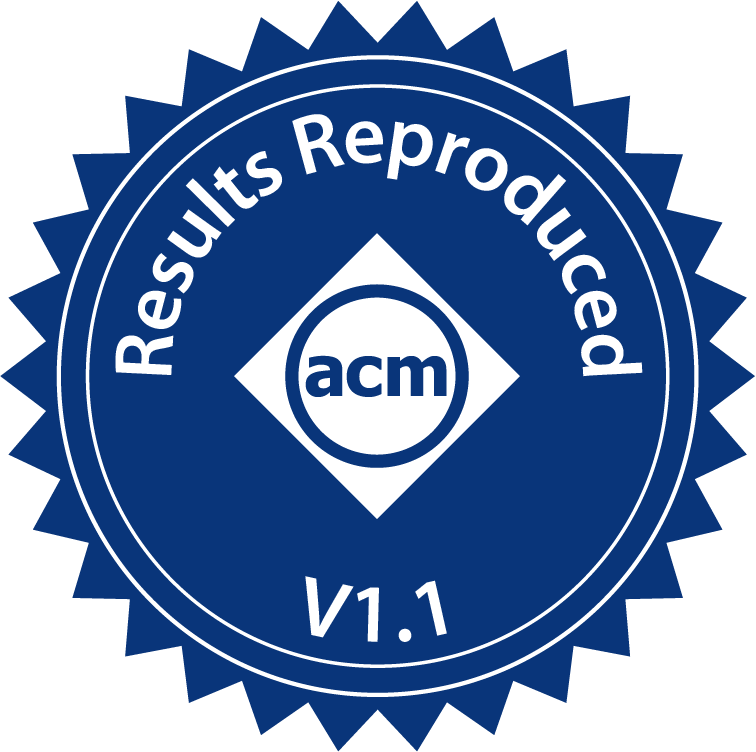Artifact Review Summary: FragPicker: A New Defragmentation Tool for Modern Storage Devices
Artifact Details
Badges Awarded
| Artifact Available | Artifact Functional | Results Reproduced |

|

|

|
Description of the Artifact
FragPicker artifact is publically available on Github (https://github.com/jonggyup/FragPicker). It provides the source code and scripts of a defragmentation tool for modern storage devices. The repository contains sufficient documentation to install FragPicker and its dependencies. The authors provide instructions for producing “the sequential read performance with various frag size and frag distance” for Figure 4 in the paper (the motivational experiments); and synthetic workloads on Optane SSD and Flash SSD for Figure 8 and 9, respectively.
Environment(s) Used for Testing
The evaluators used the following environments for the artifact evaluation:
-
A server provided by the authors: The provided server has all the storage devices needed to perform the evaluation, including HDD, SSD, Optane-SSD. The provided server has Ubuntu 18.04 LTS and Linux v5.7.0 installed.
-
CloudLab
c220g2machine: similarly Ubuntu 18.04 LTS and Linux Kernel 5.7.0 are used as the base environment. Cloudlab environment only contains an HDD and SSD (no Optane). -
The evaluator’s local server with an SSD and HDD. Ubuntu 18.04 is used as the authors suggested. In order to independently confirm the behaviors, the evaluator built and ran the benchmarks using different machines.
Step-By-Step Instructions to Exercise the Artifact
Basically, the evaluators followed the instructions provided by the authors. Some steps were skipped when the evaluators were using the author-provided server, such as “1. Evaluation Setup” because the machine has been pre-installed, and “make” the individual tests in part 2 & 3. The general steps are
- Running the motivation experiments used in Figure 4 across all 4 types of block devices (Optane, SSD, HDD and MicroSD);
-
Running the synthetic workloads (read/write + sequential/stride) across the baseline and FragPicker over 3 FSes (ext4, F2FS, and Btrfs). This step demonstrates the major claim of the paper, i.e., FragPicker achieve better bandwidth in terms of MB/s and writes less to the drives.
- For a new bare metal ubuntu 18.04 LTS instances on Cloudlab, one of the
evaluators had to first upgrade the kernel to 5.7. The evaluator then
followed the instructions in the README.md to install dependencies. Since
the block devices are different, the evaluator had to modify the bash scripts
provided by the authors to point to the right devices. The evaluator also
cleaned up the output files into more convenient tool readable csv files and
visualized results using the python/pandas/matplotlib/jupyter toolchain.
- Instructions for Cloudlab install:
- Machines used for discussion are below:
- Two Intel E5-2660 v3 10-core CPUs at 2.60 GHz (Haswell EP)
- 160GB ECC Memory (10x 16 GB DDR4 2133 MHz dual rank RDIMMs)
- HDD: HGST HUC101212CSS600 Ultrastar C10k1200 1.2tb 10000rpm Sas-6gbps 64mb Buffer 2.5inch Sff Enterprise Hard Drive
- SSD: Intel DC S3500 480 GB 6G SATA SSDs
- Steps to run the artifact on CloudLab:
- Select an Ubuntu 18.04 machine.
- Install necessary kernel packages for 5.7.0 kernel (headers, image, modules, etc.)
- Clone github repo.
- Run
./install_dep.shto install dependencies. - Install build dependencies for
bcc - Clone, build, and install
bcc - Update run scripts to reflect actual disk layout (e.g.
sdb1->SSD,sdd1->HDD) - Run all experiments using
./run_all_bench.sh
- Machines used for discussion are below:
- Instructions for Cloudlab install:
How The Artifact Supports The Paper
Overall, the evalutors reached a concensus that this artifact supports the major claims made in the paper, although some evaluators had some “inconclusive” finding during the artifact evaluation process. Details are below.
The results the evaluators got from the experimental runs were (basically) consistent with what are in the paper, including both the motivation experiments and synthetic workloads. The experiments run smoothly without hurdles. The evaluators were able to reproduce the results in overall for Figure 4 (a-d), and Figure 8 and 9. The major performance benefits claimed by FragPicker is also demonstrated through the synthetic workloads (a total set of {read, write} x {sequential, stride} x {Original, FragPicker-B, FragPicker, Conv} x {EXT4, F2FS, BtrFS} = 48 experiments. These results make up the major claims of the paper, albeit the lack of artifact for running other experiments in the evaluation section (e.g., YCSB in Figure 10, FileBench in Figure 11, and hotness test in Figure 12).
“Inconclusive” Voice from One Evaluator:
FragPicker’s performance on the SSD tested was inconclusive. The evaluators can confirm that it generally writes from one half (seq. read, seq. update) to one quarter (str. read, str. update). However performance found by one evaluator, did not correspond to the results presented in the paper. For example, for ext4 sequential reads, baseline performance is 236 MB/s while both FragPickers only obtain 238 MB/s and 242 MB/s, while conventional defrag reaches 371 MB/s. For the same benchmark, F2FS gets 231 MB/s baseline, 240 MB/s in FP-B, 230 MB/s in FP, and 362 MB/s in conventional.
Updates are more in line with the claims presented in the paper, though the not enough to entirely convince one evaluator of the conclusion “Overall, FragPicker efficiently reduces the write amount incurred by defragmentation while achieving a similar level of performance improvement as existing tools. Moreover, FragPicker even outperforms the existing tools in terms of stride I/O performance due to better utilization of internal parallelism” (p.10). In the example of the SSD, greatly underperforms conventional defragmentation in 1/4 cases, and matches in 3/4 of the cases. The greatest improvement over conventional defragmentation was 6.8% in the case of stride update on F2FS.